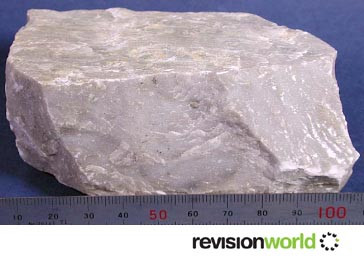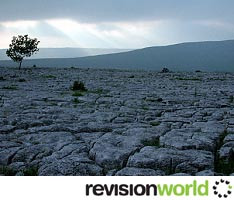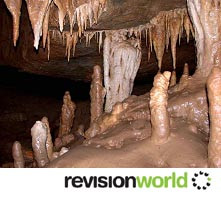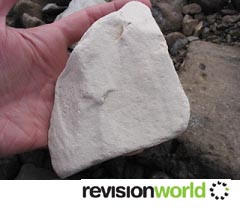Sedimentary rocks are formed when eroded fragments of old rocks and dead organisms settle (usually in seas or rivers) to form a sediment. Over millions of years, layers of sediment build up and are buried one on top of the other. They are compressed, and their weight squeezes out the water. Eventually the pieces of rock in the sediment become bonded together to form sedimentary rocks.
Sedimentary rocks are laid down in layers called beds or strata. Each new layer is laid down horizontally over older ones. There are usually some gaps in the sequence called unconformities. These represent periods in which no new sediments were being laid down, or when earlier sedimentary layers were raised above sea level and eroded away.
Sedimentary rocks contain important information about the history of the Earth. They contain fossils, the preserved remains of ancient plants and animals. The composition of sediments provides us with clues as to the original rock. Differences between successive layers indicate changes to the environment which have occurred over time. Sedimentary rocks can contain fossils because, unlike most igneous and metamorphic rocks, they form at temperatures and pressures that do not destroy fossil remnants.
This video looks at sedimentary rocks
Economic Uses
Sedimentary rocks are economically important in that they can easily be used as construction material because they are soft and easy to cut.
Sedimentary rocks often form porous and permeable reservoirs in sedimentary basins in which water and important minerals such as oil can be found.
Chalk is a valuable resource and much of it is quarried for the construction industry where it is used in the making of cement.
Limestone
Limestone is a sedimentary rock composed largely of the mineral calcium carbonate.
Pure limestone's are white or almost white. Because of impurities, such as clay, sand, organic remains, iron oxide and other materials, many limestone's exhibit different colours, especially on weathered surfaces.
If metamorphism occurs e.g. during the mountain building process limestone re-crystallises into marble.
Limestone is permeable since water can pass through the many natural cracks in the rock and it is easily dissolved by acidic rainwater. In areas of limestone, distinctive landforms will be created to give a landscape referred to as karst.

Formation of carboniferous limestone
This video looks at the geological formation of carboniferous limestone rock is illustrated. Fossil formation is mentioned but not shown. An animation shows the build up of layers of calcite (from marine organisms) combined with silt and sand which together form a grey, hard rock called limestone.
Chemical weathering by solution in upland limestone scenery
This video shows the deflation of the upland limestone landscape by slow solution weathering is demonstrated at Norber in the Yorkshire Dales. Limestone is dissolved very slowly over a period of time. Erratics at Norber are boulders of gritstone standing on a plinth of limestone. The boulders protect the limestone from chemical weathering. The depth of the limestone indicates how long the weathering has taken.
Karst Landscapes & Features
Above ground, there are areas of bare rock called limestone pavements which show distinctive clints (blocks) and grykes (grooves) and swallow holes where streams disappear underground.

Below ground, large cave systems are formed by solution along the vertical joints and horizontal bedding planes. In these caves may be narrow stalactites hanging from the ceiling and stumpy stalagmites on the cave floor. Sometimes these join to form pillars.

Springs are formed where water re-emerges back on to the surface as the rock changes from limestone to something impermeable.
Sometimes the roofs of cave systems collapse and leave narrow steep-sided limestone gorges. Some of these are dry but others may contain streams, particularly in wetter periods.
Chalk
Chalk is a soft, white, porous form of limestone composed of the mineral calcite. It is relatively resistant to erosion so forms tall steep cliffs where chalk ridges meet the sea e.g. Beachy Head along the south coast of England
Chalk is porous which means that water can pass through and be stored in the pore spaces between the particles of rock. When it rains, water infiltrates into the chalk layers and saturates the chalk. The upper level of saturation is called the water table.
Many water companies drill boreholes into the chalk rock to supply water to nearby settlements.
Chalk forms distinctive landscapes with steep escarpments and gentle dip slopes. The hills may have dry valleys which show the characteristics of a river valley but have no water flowing along them. The North and South Downs in south-east England (UK) show all these features.

Sedimentary rocks include common types such as chalk, limestone, sandstone and clay. Sedimentary rocks cover 75% of the Earth's surface.
